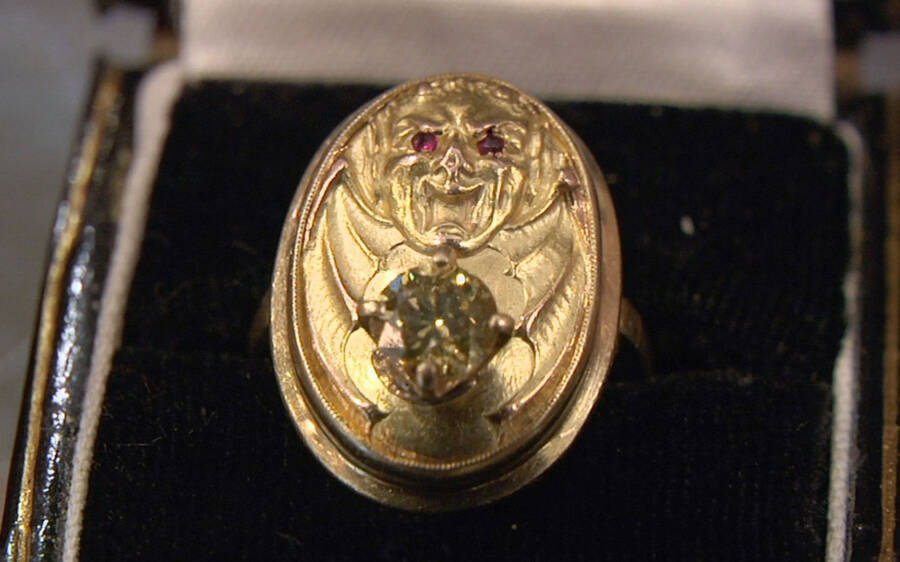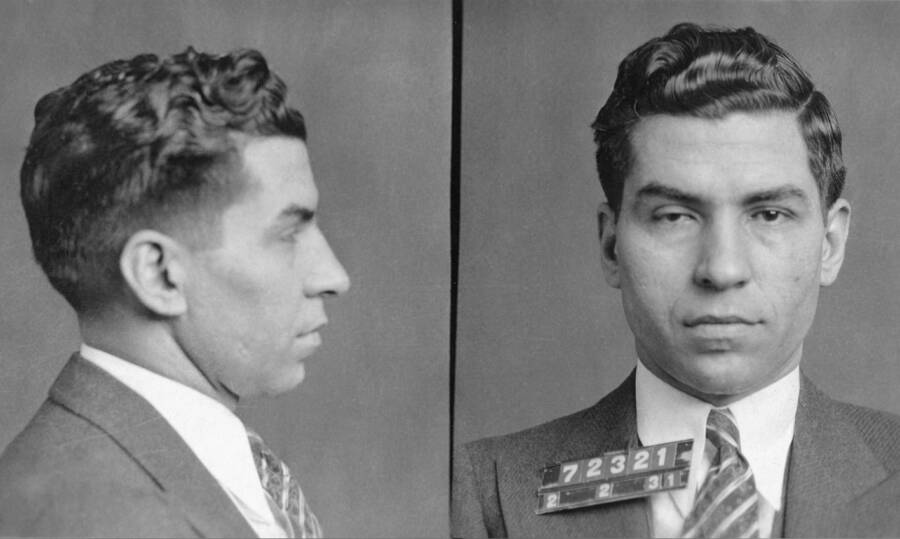A gold signet ring purportedly owned by Lucky Luciano surfaced in 2012 with a price tag of $100,000 — even though the seller had no papers to authenticate it.

Pawn Stars/YouTubeLucky Luciano’s ring was never authenticated, and first surfaced in 2012.
Lucky Luciano was known as the father of modern organized crime. Born in Italy at the turn of the century, he became a ruthless Mafia hitman in New York City and the first boss of the Genovese crime family. While his crimes were exposed at trial in 1936, it would take nearly a century for a ring that purportedly belonged to the gangster to surface.
Luciano was certainly an impeccable dresser with a penchant for golden watches. A Patek Philippe that allegedly belonged to him would be auctioned off for $36,000 in 2009 and become an entrancing piece of Mafia memorabilia for collectors. Little did anyone know that the ring would appear at a pawn shop in 2012 — and be valued at $100,000.
“I have a piece of antique heirloom jewelry that my mother passed along to me,” claimed the unidentified owner. “It was the signet ring of the mafia boss Lucky Luciano. I’ve had it in hiding for 40 years … If anybody got possession of this piece, until now, there would’ve been bloodshed and war within the families.”
Lucky Luciano And The Italian Mafia
Born Salvatore Lucania on November 24, 1897, in Sicily, the legendary gangster would be named Charles Luciano upon arriving in the United States. He was only 10 years old when his immigrant family arrived in New York City and just as old when he was first arrested for shoplifting. He graduated to theft and extortion by the time he was 14.
Luciano joined the Five Points Gang and extorted Manhattan’s Jewish youths into paying him 10 cents per week for protection against Irish and Italian gangs. That’s how he met Meyer Lansky, an ambitious young gangster himself — who refused to pay Luciano. Impressed by each other’s gall, the pair became friends.
Forming a new gang with another gangster named Benjamin “Bugsy” Siegel, they expanded their protection rackets. It was prohibition during the Roaring Twenties, however, that truly saw them come to power. Known for his loyalty and allegedly nicknamed for his luck at evading arrest, Luciano had risen in the ranks by 1925.

Wikimedia CommonsLucky Luciano was convicted in 1936 and later exiled to Italy where he died of a heart attack.
As chief lieutenant to Mafia boss Joe Masseria, Luciano was thought untouchable. That changed when rival gangsters gruesomely slashed his throat and stabbed him with an ice pick on Oct. 17, 1929. While Luciano survived with an intimidating scar, Masseria launched a war against Salvatore Maranzano in 1930.
Determined not to die under the reign of an antiquated leader, Luciano orchestrated Masseria’s murder. He invited him to dinner on Coney Island in Brooklyn, only to excuse himself to go to the restroom — and have his crew shoot Masseria in the head. He took care of Maranzano next, and became the “boss of all bosses.”
Hoping to turn the Mafia into a network of regulated businesses, Luciano organized a meeting and proposed restructuring its criminal activities into groups, thus spawning the Five Families of New York. To keep the peace, a code of silence called omertà and a governing body called the “Commission” was put in place.
Lucky Luciano’s Ring
Ultimately, Lucky Luciano’s life took a drastic turn. He went from befriending Frank Sinatra and lavishing his many mistresses with gifts to being charged with running prostitution rackets in 1935. Prosecutor Thomas Dewey called him “the most dangerous” gangster in the world during the trial — and convicted Luciano in 1936.
He would ultimately be exiled to Italy as a result of his wartime assistance to the American military, Luciano died of a heart attack on Jan. 26, 1962. Then, one of his most prized possessions was allegedly discovered in Las Vegas, Nevada, half a century later — as seen in the “Ring Around the Rockne” episode of Pawn Stars.
“I decided to come to the pawnshop today to sell my ring that belonged to Lucky Luciano, one of the most notorious mafia dons that ever existed,” said the unidentified owner. “It’s a one-of-a-kind piece that has a lot of power and a lot of authority. They’re going to want it not for its jewelry value but because of its history.”
The Mafia and Las Vegas certainly have a vast and shared history together. When Nevada banned gambling in 1919, organized crime simply filled the vacuum. It garnered a serious foothold in the industry by the time gambling was legalized in 1931. According to the owner of Lucky Luciano’s ring, it was a gift to his mother.
“There’s an individual whose name I can not use that gave this to my mother,” he said. “My mother was a woman who did special services for these people, because she had their personal confidence. These gentlemen trusted her with things that they couldn’t trust anyone else with.”
The ring was made of gold with a diamond in the middle and a demon howling above. The owner wanted $100,000 for it but had no papers of authenticity. While Luciano certainly enjoyed gold, the demon may have been too blasphemous for his Catholic faith — and a consulted expert hesitated to deem it authentic.
“I just don’t think we can conclude this is Lucky Luciano’s ring,” said Jonathan Ullman, the executive director of The Mob Museum of Las Vegas, “[but] it’s a great story.”
After learning about the Lucky Luciano ring, read about Operation Husky and Lucky Luciano’s WW2 efforts. Then, learn about Henry Hill and the real-life ‘Goodfellas.’





